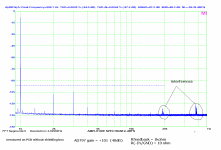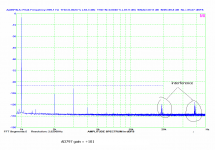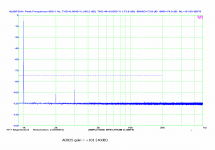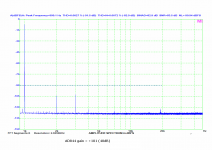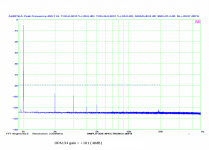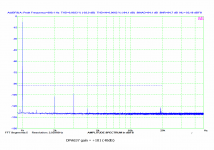That equivalent to 5 Ohms. Is it transformer coupled or many paralleled transistors(or a great many paralleled tubes)?
try InterFET IF3601 & -3602 (pair). 0.3nv for one device (not paralleled/dual). -RNM
SIM didnt show the midrange depression -
Regressing for just a second..... the phono cartridge C loading was to flatten the response to give a best + and - tolerance on the frequency response spec. Not shown in earlier sim here is that the response in the midrange always dipped when the high freq peak was 'flattened'. It created a midrange roll-off or depression. Flattening the peak added damping as well and combination always tended to make the sound 'dull'
I always liked the midrange flat. -Thx RNMarsh
Regressing for just a second..... the phono cartridge C loading was to flatten the response to give a best + and - tolerance on the frequency response spec. Not shown in earlier sim here is that the response in the midrange always dipped when the high freq peak was 'flattened'. It created a midrange roll-off or depression. Flattening the peak added damping as well and combination always tended to make the sound 'dull'
I always liked the midrange flat. -Thx RNMarsh
Under the NTE brand, they are cheap.. a couple dollars or there-abouts. Cermet multi-turn. -RNMIf this is just for dc use, I would use a w.w. pot or cermet type. How each mfr rates their parts would determine the life of the part. I would not run these liitle guys too close to their rating though. Contact (wiper) construction varies... Spectrol (now Vishay owned) uses a dual contact, gold plated for long life and stable contact resistance. They are cheap enough. NTE sells them under thier name/number. -RM
Yes.
Now here are two different schematics. Given the same values for the parts in both circuits which will have less power supply noise on the output?
Have the feeling that I'm stepping into a trap, but oh well,
I dont see where it makes a difference from a magnetics point of view, in which case the windings phases shouldn't matter.
If you are referring to capacitive coupling to each secondary, then it would seem to be more a matter of the winding method or physical geometry as JCX has mentioned.
It would seem to me that best one could do is to present the same capacitance to opposite polarities of the windings. Not easy but one could wind one turn side by side with the other winding but in the opposite rotation. This would have the opposite phases see approximately the same capacitance. You'd have wires crossing over each other but that is handled in other methods (universal wind) so I dont think it precludes this approach.
Thanks
-Tony
I am responding to the continuous insults from some guy in Australia. The rest of you can carry on as usual.
For the reason of quarrels here, I have decided to make a measurement of the AD797.
The test circuit has non-inverting gain +101, i.e. about 40dB. Feedback resistor is 1k, -IN to ground resistor is 10 ohm. Decoupling caps 100nF//4.7uF. The test circuit is built on double-sided PCB with ground plane, but no shielding box is used. FFT measurement attached. We can see no support to fairy tales that the AD797 is unable to drive its feedback network. And no significant 7th can be seen, once again the gain is 40dB. We can only see some interference above 18kHz, for the reason the test circuit is unshielded and PC and PC screen run near the circuit.
P.S.: measured at about 1Vrms.
The test circuit has non-inverting gain +101, i.e. about 40dB. Feedback resistor is 1k, -IN to ground resistor is 10 ohm. Decoupling caps 100nF//4.7uF. The test circuit is built on double-sided PCB with ground plane, but no shielding box is used. FFT measurement attached. We can see no support to fairy tales that the AD797 is unable to drive its feedback network. And no significant 7th can be seen, once again the gain is 40dB. We can only see some interference above 18kHz, for the reason the test circuit is unshielded and PC and PC screen run near the circuit.
P.S.: measured at about 1Vrms.
Attachments
Last edited:
Under the NTE brand, they are cheap.. a couple dollars or there-abouts. Cermet multi-turn. -RNM
Just got an email from Bourns support, a scanned page from an obvious older doc, saying that 'in general' cermet pots can take up to 100mA on the wiper.
This is in contradiction to the previous doc, which also was from Bourns. Doesn't give a very professional impression I'm afraid....
I think I stay with the lowest specced one.
jan
One more, again 40dB gain, artifacts below -125dB are measurement artifacts rather than opamp's, same for previous measurement.
Aha! I can actually see the 7th! You failed miserably 😀
BTW Pavel what (hardware or software) is this measurement done with?
Don't recognise the screen from one of the usual suspects.
jan
Just got an email from Bourns support, a scanned page from an obvious older doc, saying that 'in general' cermet pots can take up to 100mA on the wiper.
.......
Jan,
Can you post that doc? If your not under NDA, of course ;-)
Thanks!
Aha! I can actually see the 7th! You failed miserably 😀
.....
Pavel's measurement results are also inconsistent, if setup stayed the same.
Pavel, I must be missing something obvious- what's the difference in the test for the two spectra?
Jan,
Can you post that doc? If your not under NDA, of course ;-)
Thanks!
Attached.
Attachments
Pavel, I must be missing something obvious- what's the difference in the test for the two spectra?
The small difference is only in about 4dB of output amplitude. But it affects level of high order harmonics near -130dB, which is a measurement fault, not opamp's.
I can later measure more opamps like OPA134 etc. in the same setup, i.e. with gain +101.
BTW Pavel what (hardware or software) is this measurement done with?
Don't recognise the screen from one of the usual suspects.
jan
Hi Jan,
the software is Virtins Technology, Multi-Instrument 3.2
Virtins Technology: Turn a PC into Virtual Instrument - Home
Virtins Technology: Turn a PC into Virtual Instrument - Products
Measured with SB X-Fi HD, USB soundcard. THD 0.002% is at the limit of the card.
AD825 vs. AD797
This is the result of John's favorite AD825, compared to AD797. We can see higher noise (and distortion) with the AD825, but, as expected, much better immunity against interferences. But, it might be burried in noise for the AD825.
This is the result of John's favorite AD825, compared to AD797. We can see higher noise (and distortion) with the AD825, but, as expected, much better immunity against interferences. But, it might be burried in noise for the AD825.
Attachments
Last edited:
OPA637
And finally, OPA637. Low distortion, low noise and low sensitivity to interference. My vote 😉
No 7th!! 🙂
And finally, OPA637. Low distortion, low noise and low sensitivity to interference. My vote 😉
No 7th!! 🙂
Attachments
Last edited:
- Status
- Not open for further replies.
- Home
- Member Areas
- The Lounge
- John Curl's Blowtorch preamplifier part II
